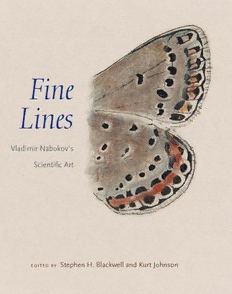
Fine lines: Vladimir Nabokov's scientific art PDF
Preview Fine lines: Vladimir Nabokov's scientific art
Fine Lines Fine Lines Vladimir Nabokov’s Scientifi c Art Edited by Stephen H. Blackwell & Kurt Johnson New Haven and London Published with assistance from the foundation Designed and typeset by Chris Crochetière, established in memory of Philip Hamilton McMil- BW&A Books, Inc. lan of the Class of 1894, Yale College. Printed in China. Frontispiece: Color Plate 21 (detail) Copyright © 2016 by Yale University. All rights reserved. Library of Congress Control Number: 2015951601 This book may not be reproduced, in whole or in isbn 978-0-300-19455-5 part, including illustrations, in any form (beyond that copying permitted by Sections 107 and 108 A catalogue record for this book is available from of the US Copyright Law and except by reviewers the British Library. for the public press), without written permission from the publishers. This paper meets the requirements of ansi/niso z39.48–1992 (Permanence of Paper). Yale University Press books may be purchased in quantity for educational, business, or promotional 10 9 8 7 6 5 4 3 2 1 use. For information, please e-mail sales.press@ yale.edu (US offi ce) or [email protected] (UK offi ce). To Dieter E. Zimmer, an inspiration to all who chase after Nabokov’s receding footsteps Minister: No, you always draw such complicated things. And look, you’ve even added shading. It’s revolting. — Vladimir Nabokov, The Waltz Invention, 1938 Contents Preface ix Acknowledgments xi Anatomical Diagrams xiii Introduction 1 Black and White Figures Old World 1–24 30 North America 25–43 54 Latin America 44–78 73 Evolution and Systematics 79–87 108 Wings 88–91 117 Measurements 92 123 Color Plates Old World 1–27 126 North America 28–32 153 Latin America 33–36 158 Evolution and Systematics 37 162 Wings 38–56 163 Inscriptions to Véra 57–62 182 Plates to Essays E1–E13 188 Essays Drawing with Words: The Toothwort White and Related Natural History Motifs in Pale Fire | Robert Dirig 201 A Few Notes on Nabokov’s Childhood Entomology | Victor Fet 216 Chance, Nature’s Practical Jokes, and the “Non- Utilitarian Delights” of Butterfl y Mimicry | Victoria N. Alexander 225 Nabokov’s Evolution | James Mallet 235 Fictional Realism: Scaling the Twin Peaks of Art and Science | Dorion Sagan 243 Mountains of Detail: On the Trail with Nabokov’s Blues | Lauren K. Lucas, Matthew L. Forister, James A. Fordyce, and Chris C. Nice 251 Nabokov’s Morphology: An Experiment in Appropriated Terminology | Stephen H. Blackwell 260 Swift and Underwing, Boulderfi eld and Bog: How Nabokov Drew the World from Its Details | Robert Michael Pyle 269 Enchanted Hunting: Lolita and Lolita, Diana and diana | Brian Boyd 277 Nabokov’s Notes and Labels from the Museum of Comparative Zoology: Boon for a Recondite Biographer or Data for a Serious Systematist? | Naomi E. Pierce, Rodney Eastwood, Roger Vila, Andrew Berry, and Thomas Dai 285 Chronology of Nabokov’s Life 295 Bibliography 297 List of Contributors 305 Illustration Credits 307 Index 311 viii Contents Preface This book represents a landmark moment in the understanding of Vladimir Nabokov as a scientist. After three decades of neglect and two decades of scientifi c confi rmation and revision, it is fi nally possible to present a comprehensive review of his achievement. The collection of drawings gathered here also off ers a rich window into his visual engagement with the world of microscopic structures found inside butterfl ies. Nabokov’s visual passion resulted in well over a thousand drawings, one hundred and forty-eight of which are in- cluded here. These drawings, and the way Nabokov used them in his research, give import- ant insight into how he perceived the world and attempted to know it, and these insights, in turn, shed light on his artistic perception and creativity. Never before has any appraisal of Nabokov’s research been based on a thorough review of his laboratory notes, which, combined with his published scientifi c papers and the recent DNA-based confi rmations of two of his most controversial hypotheses, allow new clarity in understanding the signifi cance of his work and locating it in the contexts of evolution- ary biology and systematics. Jotted notes accompanying many drawings reveal details of his discovery process, showing how he sought to understand the evolutionary diversity of Blue butterfl ies by means of morphology. The notes clarify Nabokov’s uncanny sense of the interplay of temporal, spatial, and developmental factors underlying the major evolution- ary and taxonomic questions of his day. Viewed in extended sequence across many cards, the drawings allow an understanding of how he sought to trace the temporal—indeed the evolutionary—history of the species he studied. Aesthetically, too, they present an unusual temporal picture—one that brings to mind Nabokov’s habit of writing his novels on similar note cards, working in nonlinear fashion, and thinking of novelistic time as a painted can- vas or foldable magic carpet. After an Introduction that provides a full historical and theoretical context for Nabokov’s evolutionary work and its relation to his art, the captions to the drawings tell a fascinating story of how Nabokov conducted his research, how he chose his comparison groups, and how he identifi ed new distinguishing features of butterfl y genitalia. We place the draw- ings together, in two groups (ninety-two black-and-white, fi fty-six in color) between the Introduction and the essays, so that the reader can view them all in close contiguity to one another, much as Nabokov might have reviewed large groups of drawings as he worked to discover relationships between butterfl y species and construct hypotheses for their origins. Extended contemplation of the drawings opens the opportunity for a cumulative aesthetic impact, as the drawings’ composition and strange contents work their way into the view- er’s perceptual framework. We intend this organization to facilitate the research of histo- rians of science as well as that of those who undertake to study the drawings as aesthetic artifacts. ix
